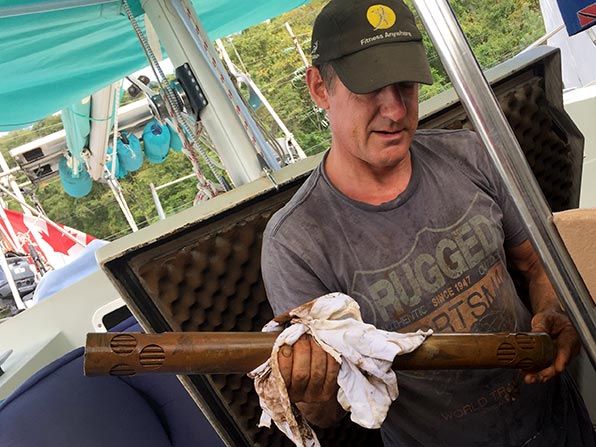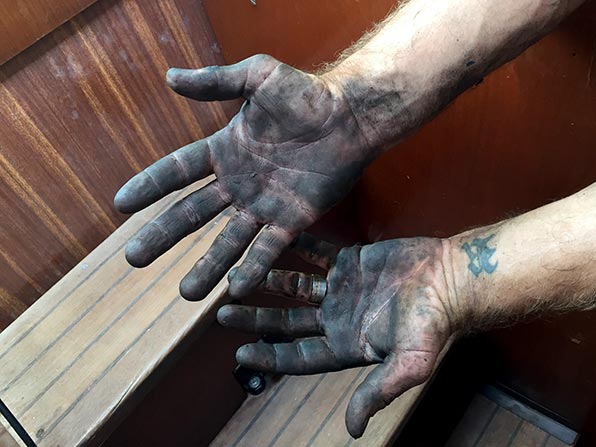Getting to the core of the problem
Since the time we made our first passage on the Amel, I have been unconvinced that the cooling system on our Perkins diesel has been working as well as it should be. Even though we seem to be getting good water flow from the exhaust, I only seem to be able to keep the engine temperature (measured on the gauge, not a heat gun) within the operating range if I run the engine at a lower RPM than it is rated for. With no plans to sail her anywhere in the next little while, yesterday seemed to be as good a time as any to look into the situation.

Our engine is a Perkin’s 4.154.

Schematic diagram for the cooling circuit.

I changed the impeller on the water pump back in September.

The core from the heat exchanger. I sent it off to be cleaned and pressure tested.

There’s always 1 nut that takes as much time to remove as everything else!

Now I know why that foam is there… to rest your head on.

Making thermostat soup?

The thermostat on the right is the one that was in the engine. It failed to open!
The one on the left is a spare that I found on the boat. One problem found.

I really should learn to wear gloves!


Mike;
You can also use unsweetened kool aid to clean the seawater side of your cooler, it is nothing more than mild citric acid. We cleaned our fire hose nozzles in the navy the same way. A lot easier to store on a boat than some jug of salt away.
And more tasty too!
Interesting idea!!
Gosh, i wish i was as handy as you Mike…
Spent my life in the financial world. My wife tells me to please stay away from building or fixing. Always costs twice as much. Them fixing my fixing then fixing what needed fixing in the first place..lol
I didn’t grow up “handy.” If it is at all true, it has been acquired through necessity.
Did you check to make sure you aren’t over propped?
What rpm can you reach when in neutral?
What rpm can you reach when in gear?
If the difference is more than a couple hundred rpm you may be over propped.
I don’t know the answers to your questions but of all the causes of an engine overheating, I have to imagine that this would be fairly low on the list. While I don’t know this for certain, one would assume that the prop is original and that Amel knew what they were doing.
Ahhh . . . the pleasures of owning a boat! It seems like there is always something that needs repair.
It doesn’t just SEEM that way, it IS that way.
When I used to work on cars a lot I would put a small amount of Dawn dish soap on my hands and rub it in like lotion. This made the cleanup so much easier.
Would that not make your hands slippery? I have a hard enough time gripping tools and nuts/bolts as it is.
One nut takes longer to undo……every…….single…….time….
Fact!
From “The Hitchhikers Guide To The Galaxy”:
“The major difference between a thing that might go wrong and a thing that cannot possibly go wrong is that when a thing that cannot possibly go wrong goes wrong it usually turns out to be impossible to get at or repair.”
Sounds true.
I’ve learned to love those 10-for-a-dollar cotton gloves with a light PVC coating on the palm and fingers. They fit better than any other mechanic’s glove, protect against minor cuts, and are so cheap that there is no need to use them more than a few times. Good for painting too. They don’t do a great job at keeping you clean, but they help and you can pick up a dime. Very helpful for mechanical work in cooler temperatures too.
Protects against minor cuts… I have half a dozen just from yesterday.
Hey Mike, I’ll be watching your follow up posts on this subject. My Perkins 4.108 runs a little on the hotter side. I’ve not tried EVERYTHING to figure the problem out, but I’ve done the easier things. What temps are you running on your Perkins?
I’m quite novice at the whole engine stuff, but I’m running 80 – 82C on the gauge. Using an infrared thermometer I’m getting around 80C at the hottest part of the engine – which appears to be the base of the head.
The specs that I have say a 4.108 should run between 65 and 93. Yours seems right on the money from what I can see.
A 4.154 like we have should run between 75-91. Ours, when run at only 2100 RPM, is at the top of that scale. If I run it higher, even at 2500 (the specs say 3000 RPM), it will jump out of that range.
That is some good info. My mechanic had told me 75 max. All my research online just had people disagreeing on what it should be. I like your specs. Takes a lot of concern off of me.
What I quoted is direct from the manual.
The strange thing for me is that for each of the Perkins engines, and Yanmars too, I believe, there is a max RPM and a working RPM. They are typically different:
For example, on the 4.108:
Max Intermittent Speed: 3600 (4000 special rating), Max Continuous Speed: 3000
On the 4.154, and only on the 4.154, they are the same: 3000
Why???
Mike,
One thing to make a note of. Take off the ring before working on engines. Between electrical hazards and crush hazards it can make for a really bad day. As hard as grease is to get off your hands its even harder to get off the upholstery. I get to where I pull the gloves before even climbing out of the engine compartment when possible.
You’re right. I do take it off before messing with anything obviously electrical, but I should have it off then too.